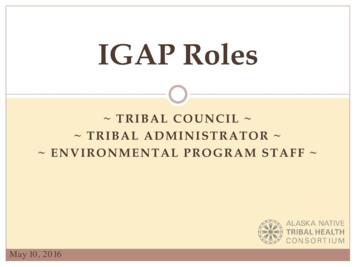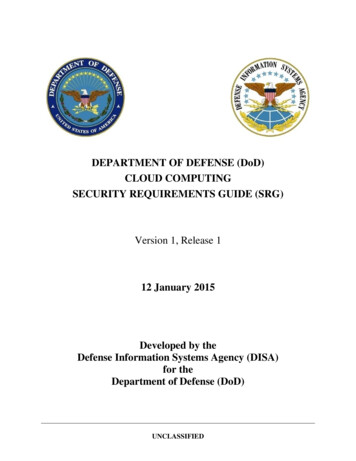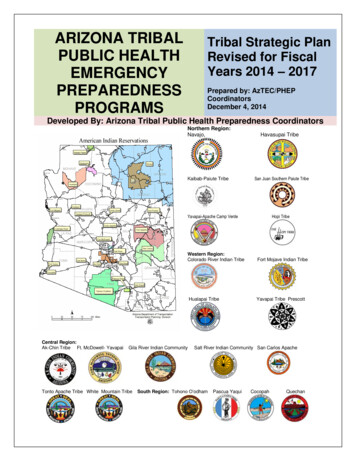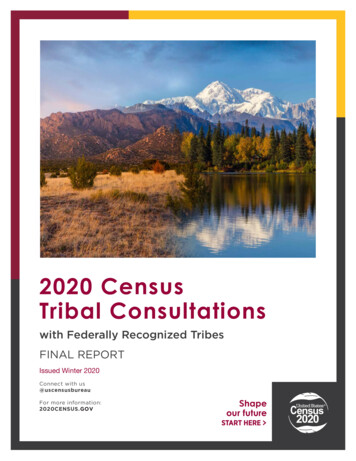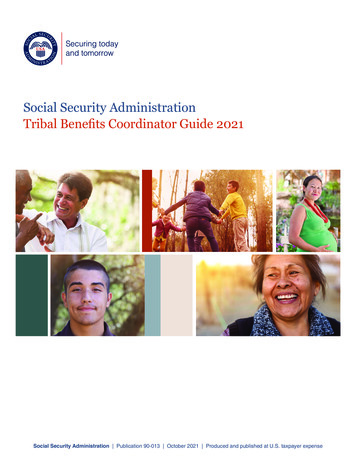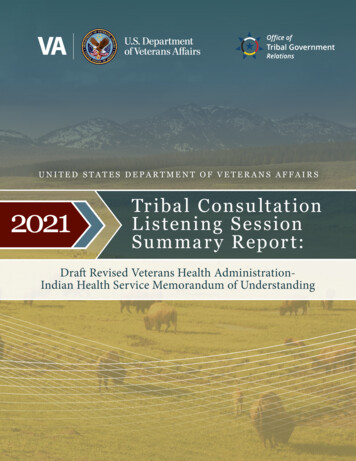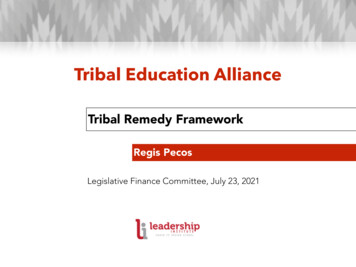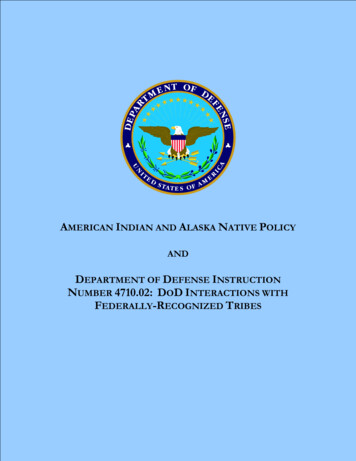
Transcription
AMERICAN INDIAN AND ALASKA NATIVE POLICYANDDEPARTMENT OF DEFENSE INSTRUCTIONNUMBER 4710.02: DOD INTERACTIONS WITHFEDERALLY-RECOGNIZED TRIBES
U.S. DEPARTMENT OF DEFENSEAMERICAN INDIAN AND ALASKA NATIVE POLICYPREAMBLEThese principles establish the Department of Defense’s (DoD) American Indian and Alaska Native Policyfor interacting and working with federally-recognized American Indian and Alaska Native governments(hereinafter referred to as “tribes”1)(a). These principles are based on tribal input, federal policy, treaties,and federal statutes. The DoD policy supports tribal self-governance and government-to-governmentrelations between the federal government and tribes. Although these principles are intended to providegeneral guidance to DoD Components on issues affecting tribes2 (b), DoD personnel must consider theunique qualities of individual tribes when applying these principles, particularly at the installation level.These principles recognize the importance of increasing understanding and addressing tribal concerns,past, present, and future. These concerns should be addressed prior to reaching decisions on matters thatmay have the potential to significantly affect (c&d) protected tribal resources, tribal rights, or Indianlands3 (e).1As defined by most current Department of Interior/Bureau of Indian Affairs list of tribal entities published in Federal Registerpursuant to Section 104 of the Federally Recognized Indian Tribe List Act.2This policy is not intended to, and does not, grant, expand, create, or diminish any legally enforceable rights, benefits, or trustresponsibilities, substantive or procedural, not otherwise granted or created under existing law. Nor shall this policy be construedto alter, amend, repeal, interpret, or modify tribal sovereignty, any treaty rights, or other rights of any Indian tribes, or to preempt,modify, or limit the exercise of any such rights.3Definition of Key Terms: Protected Tribal Resources: Those natural resources and properties of traditional or customary religious or culturalimportance, either on or off Indian lands, retained by, or reserved by or for, Indian tribes through treaties, statutes, judicialdecisions, or executive orders, including tribal trust resources. Tribal Rights: Those rights legally accruing to a tribe or tribes by virtue of inherent sovereign authority, unextinguishedaboriginal title, treaty, statute, judicial decisions, executive order or agreement, and that give rise to legally enforceableremedies. Indian Lands (f): Any lands title to which is either: 1) held in trust by the United States for the benefit of any Indian tribeor individual; or 2) held by any Indian tribe or individual subject to restrictions by the United States against alienation.(a) This policy governs Department interactions with federally recognized tribes only; it does not govern interaction withunrecognized tribes, state-recognized tribes, Alaska Native corporations, or Native Hawaiian Organizations. [In Alaska, as apractical matter, the Department may be required to consult with Alaska Native corporations simply because these corporateentities own and manage much of the land in Alaska. In addition, all Federal agencies must consult with Alaska Nativecorporations “on the same basis as Indian tribes under Executive Order No. 13175.” See section 161 of Public Law 108-199 (188Stat. 452), as amended by section 518 of Public Law 108-447 (118 Stat. 3267)]. DoD interactions with Native HawaiianOrganizations are governed by Department of Defense Instruction 4710.03, “Consultation With Native Hawaiian Organizations,”issued on October 25, 2011. A copy of the Instruction is available at www.denix.osd.mil/na/hawaii.(b) This policy neither enlarges nor diminishes the Department's legal obligations with respect to federally recognized tribes, nordoes the policy provide an independent cause of action upon which the Department may be sued.(c) The phrase "may have the potential to significantly affect," which appears throughout the policy, establishes the generalthreshold or "trigger" for consultation to be used unless a statute or other legal obligation specifically establishes a lowerthreshold for consultation. It is expected that DoD personnel will informally contact interested tribes whenever there is any realpossibility that tribal interests may be affected by proposed DoD actions, but that continued, more formal consultation will benecessary only when it appears, from initial discussions with a tribe, that tribal interests will be significantly affected by theproposed action. In other words, the policy anticipates a two-step process designed first, to overcome the fact that, as nonIndians, we may not always recognize the effect our actions may have on tribal interests unless we ask; and second, to permitDoD to proceed without the need for further consultation unless potentially significant consequences are identified during thisinitial discussion. [Note: The word "significantly" is used in this policy in its ordinary dictionary sense; i.e., as a synonym for–1–
U.S. DEPARTMENT OF DEFENSE"material" or "important." It should not be interpreted in the NEPA or Council on Environmental Quality NEPA Regulationssense, as that would set a higher threshold for consultation than is intended.](d) There is no obligation to consult with tribes absent a proposal that "may have the potential to significantly affect" tribalinterests. In other words, the obligation to consult with tribes under this policy is event- or proposal-driven. Nonetheless, as amatter of discretion, general consultation may be desirable where an installation expects to have frequent interaction with a tribeand wishes to establish a stand-by protocol for consultation absent the pressures associated with a particular proposal.(e) The phrase "protected tribal resources, tribal rights, or Indian lands," which appears throughout the policy, works inconjunction with the "may have the potential to significantly affect" trigger to determine when DoD must consult with tribes.Generally speaking, DoD must consult with tribes only when its proposed actions may have the potential to significantly affectIndian lands, treaty rights, or other tribal interests protected by statute, regulation, or executive order. [Note: Some statutes mayestablish a lower threshold for consultation than the default threshold established in this policy (see, e.g., 16 U.S.C.470a(d)(6)(B)); in such cases, the Department must consult with tribes in accordance with the statutory requirements.] [Note also,that individual rural residents of Alaska, including both Natives and non-Natives, generally have a right to engage in nonwastefulsubsistence uses of fish, wildlife, and other wild, renewable resources on public lands in Alaska. While this right is not a tribalright per se, installations nonetheless may find it both convenient and beneficial to consult with the appropriate Alaska Nativeentity whenever a proposed DoD action may have the potential to adversely affect the subsistence activities of several membersof the same village or tribe.](f) With respect to Alaska, the term "Indian Lands" does not include lands held by Alaska Native Corporations or lands conveyedin fee to an Indian Reorganization Act entity or traditional village council; the term may include village-owned townsite lands(depending on the particular status of the village itself and upon a fact-specific inquiry into whether the area at issue qualifies as adependent Indian community), and individual Native townsite lots and Native allotments (so long as these properties remain ineither restricted fee or trust allotment form).–2–
AMERICAN INDIAN AND ALASKA NATIVE POLICYI. TRUST RESPONSIBILITIESDoD will meet its responsibilities to tribes. These responsibilities are derived from: Federal trust doctrine (g) (i.e., the trust obligation of the United States government to the tribes);Treaties, Executive Orders, Agreements, Statutes, and other obligations between the UnitedStates government and tribes, to include:1. Federal statutes (e.g., Native American Graves Protection and Repatriation Act, American IndianReligious Freedom Act, National Environmental Policy Act, National Historic Preservation Act, AlaskaNational Interest Lands Conservation Act, Alaskan Native Claims Settlement Act, and ArcheologicalResources Protection Act); and2. Other federal policies (e.g., Executive Order 12898, “Environmental Justice”; Executive Order13007, “Indian Sacred Sites”; Executive Order 13021 “Tribal Colleges and Universities”; “ExecutiveMemorandum: Government to Government Relations with Native American Tribal Governments,” dated29 April 1994; and Executive Order 13084, “Consultation and Coordination with Indian TribalGovernments”).DoD will annually review the status of relations with tribes to ensure that DoD is: Fulfilling its federal responsibilities; andAddressing tribal concerns related to protected tribal resources, tribal rights, or Indian lands.(g) Under the federal trust doctrine, the United States--and individual agencies of the federal government--owe a fiduciary duty toIndian tribes. The nature of that duty depends on the underlying substantive laws (i.e., treaties, statutes, agreements) creating theduty. Where agency actions may affect Indian lands or off-reservation treaty rights, the trust duty includes a substantive duty toprotect these lands and treaty rights "to the fullest extent possible." Otherwise, unless the law imposes a specific duty on thefederal government with respect to Indians, the trust responsibility may be discharged by the agency's compliance with generalstatutes and regulations not specifically aimed at protecting Indian tribes.–3–
U.S. DEPARTMENT OF DEFENSEII. GOVERNMENT TO GOVERNMENT RELATIONSBuild stable and enduring relationships with tribes by: Communicating with tribes on a government-to-government basis (h) in recognition of theirsovereignty;Requiring meaningful communication addressing tribal concerns between tribes and militaryinstallations at both the tribal leadership-to-installation commander and the tribal staff-toinstallation staff levels (i);Establishing a senior level tribal liaison in the Office of the Secretary of Defense (j) and otherappropriate points of contact within DoD to ensure that tribal inquiries are channeled toappropriate officials within DoD and responded to in a timely manner;Providing, to the extent permitted by DoD authorities and procedures, information concerningopportunities available to tribes to: 1) compete for contracts, subcontracts, and grants, andparticipate in cooperative agreements; 2) benefit from education and training; 3) obtainemployment; and 4) obtain surplus equipment and property;Assessing, through consultation, the effect of proposed DoD actions that may have the potentialto significantly affect protected tribal resources, tribal rights, and Indian lands before decisionsare made (k);Taking appropriate steps to remove any procedural or regulatory impediments to DoD workingdirectly and effectively with tribes on activities that may have the potential to significantly affectprotected tribal resources, tribal rights, and Indian lands; andWorking with other federal agencies, in consultation with tribes, to minimize duplicative requests(l) for information from tribes.(h) Indian tribes have been called "domestic dependent nations"--i.e., nations within a nation. As such, consultation with tribes ona "government-to-government basis" requires a high degree of formality. Unless--or until--a tribal-specific protocol forconsultation has been developed, formal contact with a tribe should be made by the installation commander, and should bedirected to the tribe's senior elected official, usually referred to as the tribal chair, governor, or president.(i) Although communication with tribes on a government-to-government basis demands attention--at least initially--at a relativelysenior level of command, the goal should be to develop mutually acceptable protocols or procedures that will allow most day-today liaison and work with interested tribes to be accomplished on a staff-to-staff basis. Senior commanders and tribal leadersshould be kept apprised of this day-to-day interaction, but--once these protocols are in place--need act personally and directlyonly when requested to do so by the other party.(j) Although the Deputy Under Secretary of Defense for Environmental Security will provide tribes with a senior-level liaison toensure tribal inquires are promptly addressed, DoD officials at all levels of command should strive to make it easier for tribes toreceive timely answers to the questions they may have concerning DoD activities that may affect them. One way to accomplishthis at the installation level could be to designate and announce a principal point-of-contact for the receipt of tribal inquiries.(k) The single most important element of consultation is to initiate the dialogue with potentially affected tribes before decisionsaffecting tribal interests are made. Meaningful consultation demands that the information obtained from tribes be givenparticular, though not necessarily dispositive, consideration; this can happen only if tribal input is solicited early enough in theplanning process that it may actually influence the decision to be made. Consultation is worth very little if decisions have alreadybeen made.(l) Keep in mind that many tribes have relatively few enrolled members and only a limited staff to respond to your requests. Thisbeing the case, coordinate your requests for information with other federal agencies whenever doing so may reduce theadministrative burden on the affected tribe.–4–
AMERICAN INDIAN AND ALASKA NATIVE POLICYIII.CONSULTATIONFully integrate (down to staff officers at the installation level) the principle and practice of meaningfulconsultation and communication with tribes by: Recognizing that there exists a unique and distinctive political relationship between the UnitedStates and the tribes that mandates that, whenever DoD actions may have the potential tosignificantly affect protected tribal resources, tribal rights, or Indian lands, DoD must provideaffected tribes an opportunity to participate in the decision-making process that will ensure thesetribal interests are given due consideration in a manner consistent with tribal sovereign authority(m);Consulting consistent with government-to-government relations and in accordance with protocolsmutually agreed to (n) by the particular tribe and DoD, including necessary dispute resolutionprocesses;Providing timely notice to, and consulting with, tribal governments prior to taking any actionsthat may have the potential to significantly affect protected tribal resources, tribal rights, or Indianlands;Consulting in good faith throughout the decision-making process (o); andDeveloping and maintaining effective communication, coordination, and cooperation with tribes,especially at the tribal leadership-to-installation commander level and the tribal staff-toinstallation staff levels.(m) What constitutes "due consideration.consistent with tribal sovereignty" depends, in part, on the underlying law that dictatesthat consultation take place. "Consultation" can vary from simple notice of a pending action to negotiation to obtain the tribe'sformal consent to a proposed action (the absence of which may be enough to stop that action from proceeding). The attachedtable summarizes the specific legal obligations owed tribes under the trust doctrine and various statutes. In general, two principlesshould be kept in mind. One, tribes are not just another interested party; where tribal interests may be significantly affected, tribesmust be regarded as separate from the general public for the purposes of consultation. Second, in most cases, consultation shouldinclude an invitation to potentially affected tribes to provide information to DoD concerning actions that may significantly affecttribal interests; that information should be given special consideration. In some instances, e.g., where Indian lands or treaty rightsmay be significantly and adversely affected, tribal rights may take precedence and dictate that DoD protect these rights to thefullest extent possible.(n) The are over 570 federally recognized Indian tribes, each with its own distinctive cultural identity. Just as is true with foreignnations, a "one-size-fits-all" prescription for consultation with Indian tribes is neither appropriate nor possible. Instead,installations should expect to have to negotiate a mutually agreeable protocol with each separate tribe with which it must consult.While certain elements can be expected to be a part of any such protocol, installations should be mindful of the fact that tribes allhave different ways of controlling property, harvesting natural resources, revering the environment, and even conductingconsultations.(o) Keep it in mind that the consultation trigger contemplates a two-step process. Consultation need continue throughout thedecision-making process only for those proposals that have the potential to significantly affect tribal interests.–5–
U.S. DEPARTMENT OF DEFENSEIV. NATURAL AND CULTURAL RESOURCES PROTECTIONRecognize and respect the significance tribes ascribe to certain natural resources and properties oftraditional or customary religious or cultural importance by: Undertaking DoD actions and managing DoD lands consistent with the conservation of protectedtribal resources and in recognition of Indian treaty rights to fish, hunt, and gather resources atboth on- and off-reservation locations (p);Enhancing, to the extent permitted by law, tribal capabilities to effectively protect and managenatural and cultural tribal trust resources (q) whenever DoD acts to carry out a program that mayhave the potential to significantly affect those tribal trust resources;Accommodating, to the extent practicable and consistent with military training, security, andreadiness requirements, tribal member access to sacred and off-reservation treaty fishing, hunting,and gathering sites located on military installations; andDeveloping tribal specific protocols to protect (r), to the maximum extent practicable andconsistent with the Freedom of Information Act, Privacy Act, National Historic Preservation Act,and Archeological Resources Protection Act, tribal information regarding protected tribalresources that has been disclosed to, or collected by, the DoD.WILLIAM S. COHENSECRETARY OF DEFENSEOctober 20, 1998(p) Fulfillment of the trust responsibility demands that federal agencies protect the lands and habitats that support the resourcesupon which the meaningful exercise of tribal hunting, fishing, and gathering rights depend. This includes actions on non-Indianowned lands (including DoD installations) that may affect Indian lands or off-reservation treaty rights (such as reserved rights tohunt, fish, or gather on treaty-ceded lands or "usual and accustomed" grounds and stations). In addition, in Alaska, DoD mustendeavor to protect the continued viability of all wild, renewable resources in order to minimize, to the extent possible, theadverse effects of its actions on rural residents who depend upon subsistence uses of such renewable resources.(q) Where a proposed DoD action may have the potential to significantly affect tribal trust resources (i.e., Indian lands or treatyrights to certain resources) or DoD has been given express statutory authority (e.g., §8050 of the Department of DefenseAppropriations Act of FY 1999), DoD may have limited authority to help develop and enhance the affected tribe's capacity tobetter manage these resources. This, however, is an area fraught with fiscal law pitfalls; consequently, installations are advised toconsult with legal counsel before committing to expend appropriated funds for this purpose.(r) Presently, legal authority to protect tribal information concerning sacred sites is very limited. Section 9 of the ArcheologicalResources Protection Act (16 U.S.C. § 470hh) and Section 304 of the National Historic Preservation Act (16 U.S.C. § 470w-3)may provide some protection from a request for such information, but may not be enough to guarantee confidentiality in the faceof a Freedom of Information Act request for disclosure--especially the NHPA provision. A written consultation agreement with atribe may be appropriate in some circumstances and permit an installation to withhold disclosure under FOIA Exemption 5, buteven this tactic may prove to be ineffective. As a consequence, installations should be careful not to overstate their ability to keepsensitive tribal information confidential.–6–
AMERICAN INDIAN AND ALASKA NATIVE POLICYGOVERNMENT-TO-GOVERNMENT RELATIONS WITHNATIVE AMERICAN TRIBAL GOVERNMENTSEXECUTIVE MEMORANDUMApril 29, 1994The United States Government has a unique legal relationship with Native American tribal governmentsas set forth in the Constitution of the United States, treaties, statutes, and court decisions. As executivedepartments and agencies undertake activities affecting Native American tribal rights or trust resources,such activities should be implemented in a knowledgeable, sensitive manner respectful of tribalsovereignty. Today, as part of a historic meeting, I am outlining principles that executive departments andagencies, including every component bureau and office, are to follow in their interactions with NativeAmerican tribal governments. The purpose of these principles is to clarify our responsibility to ensure thatthe Federal Government operates within a government-to-government relationship with federallyrecognized Native American tribes.I am strongly committed to building a more effective day-to-day working relationship reflecting respectfor the rights of self government due the sovereign tribal governments.In order to ensure that the rights of sovereign tribal governments are fully respected, executive branchactivities shall be guided by the following:(a) The head of each executive department and agency shall be responsible for ensuring that thedepartment or agency operates within a government-to-government relationship with federally-recognizedtribal governments.(b) Each executive department and agency shall consult, to the greatest extent practicable and to theextent permitted by law, with tribal governments prior to taking actions that affect federally recognizedtribal governments. All such consultations are to be open and candid so that all interested parties mayevaluate for themselves the potential impact of relevant proposals.(c) Each executive department and agency shall assess the impact of Federal Government plans, projects,programs, and activities on tribal trust resources and assure that tribal government rights and concerns areconsidered during the development of such plans, projects, programs and activities.(d) Each executive department and agency shall take appropriate steps to remove any proceduralimpediments to working directly and effectively with tribal government on activities that affect the trustproperty and/or governmental rights of the tribes.(e) Each executive department and agency shall work cooperatively with other federal departments andagencies to enlist their interest and support in cooperative efforts, where appropriate, to accomplish thegoals of this memorandum.(f) Each executive department and agency shall apply the requirements of Executive Orders Nos. 12875(“Enhancing the Intergovernmental Partnership”) and 12866 (“Regulatory Planning and Review”) todesign solutions and tailor Federal programs, in appropriate circumstances, to address specific or uniqueneeds of tribal communities.–7–
U.S. DEPARTMENT OF DEFENSEThe head of each executive department and agency shall ensure that the department or agency’s bureausand components are fully aware of this memorandum, through publication or other means, and that theyare in compliance with its requirements.This memorandum is intended only to improve the internal management of the executive branch and isnot intended to, and does not, create any right to administrative or judicial review, or any other right orbenefit or trust responsibility, substantive or procedural, enforceable by a party against the United States,its agencies or instrumentalities, its officers or employees, or any other person.The Director of the Office of Management and Budget is authorized and directed to publish thismemorandum in the Federal Register.WILLIAM J. CLINTONTHE WHITE HOUSEApril 29, 1994–8–
AMERICAN INDIAN AND ALASKA NATIVE POLICYINDIAN SACRED SITESEXECUTIVE ORDER 13007May 24, 1996By the authority vested in me as President by the Constitution and the laws of the United States, infurtherance of Federal treaties, and in order to protect and preserve Indian religious practices, it is herebyordered:Section 1. Accommodation of Sacred Sites. (a) In managing Federal lands, each executive branch agencywith statutory or administrative responsibility for the management of Federal lands shall, to the extentpracticable, permitted by law, and not clearly inconsistent with essential agency functions,(1) accommodate access to and ceremonial use of Indian sacred sites by Indian religious practitioners and(2) avoid adversely affecting the physical integrity of such sacred sites. Where appropriate, agencies shallmaintain the confidentiality of sacred sites.(b) For purposes of this order:(i) “Federal lands” means any land or interests in land owned by the United States, including leaseholdinterests held by the United States, except Indian trust lands;(ii) “Indian tribe” means an Indian or Alaska Native tribe, band, nation, pueblo, village, or communitythat the Secretary of the Interior acknowledges to exist as an Indian tribe pursuant to Public Law No. 103454, 108 Stat. 4791, and “Indian” refers to a member of such an Indian tribe; and(iii) “Sacred site” means any specific, discrete, narrowly delineated location on Federal land that isidentified by an Indian tribe, or Indian individual determined to be an appropriately authoritativerepresentative of an Indian religion, as sacred by virtue of its established religious significance to, orceremonial use by, an Indian religion; provided that the tribe or appropriately authoritative representativeof an Indian religion has informed the agency of the existence of such a site.Section 2. Procedures. (a) Each executive branch agency with statutory or administrative responsibilityfor the management of Federal lands shall, as appropriate, promptly implement procedures for thepurposes of carrying out the provisions of section 1 of this order, including, where practicable andappropriate, procedures to ensure reasonable notice is provided of proposed actions or land managementpolicies that may restrict future access to or ceremonial use of, or adversely affect the physical integrityof, sacred sites. In all actions pursuant to this section, agencies shall comply with the Executivememorandum of April 29, 1994, “Government-to-Government Relations with Native American TribalGovernments.”(b) Within 1 year of the effective date of this order, the head of each executive branch agency withstatutory or administrative responsibility for the management of Federal lands shall report to thePresident, through the Assistant to the President for Domestic Policy, on the implementation of this order.Such reports shall address, among other things, (i) any changes necessary to accommodate access to andceremonial use of Indian sacred sites; (ii) any changes necessary to avoid adversely affecting the physicalintegrity of Indian sacred sites; and (iii) procedures implemented or proposed to facilitate consultationwith appropriate Indian tribes and religious leaders and the expeditious resolution of disputes relating to–9–
U.S. DEPARTMENT OF DEFENSEagency action on Federal lands that may adversely affect access to, ceremonial use of, or the physicalintegrity of sacred sites.Section 3. Nothing in this order shall be construed to require a taking of vested property interests. Norshall this order be construed to impair enforceable rights to use of Federal lands that have been granted tothird parties through final agency action. For purposes of this order, “agency action” has the samemeaning as in the Administrative Procedures Act (5 U.S.C.551[13]).Section 4. This order is intended only to improve the internal management of the executive branch and isnot intended to, nor does it, create any right, benefit, or trust responsibility, substantive or procedural,enforceable at law or equity by any party against the United States, its agencies officers, or any person.WILLIAM J. CLINTONTHE WHITE HOUSEMay 24, 1996– 10 –
AMERICAN INDIAN AND ALASKA NATIVE POLICYCONSULTATION AND COORDINATION WITH INDIAN TRIBAL GOVERNMENTSEXECUTIVE ORDER 13175November 6, 2000By the authority vested in me as President by the Constitution and the laws of the United States ofAmerica, and in order to establish regular and meaningful consultation and collaboration with tribalofficials in the development of Federal policies that have tribal implications, to strengthen the UnitedStates government-to-government relationships with Indian tribes, and to reduce the imposition ofunfunded mandates upon Indian tribes; it is hereby ordered as follows:Section 1. Definitions. For purposes of this order:(a) “Policies that have tribal implications” refers to regulations, legislative comments or proposedlegislation, and other policy statements or actions that have substantial direct effects on one or moreIndian tribes, on the relationship between the Federal Government and Indian tribes, or on the distributionof power and responsibilities between the Federal Government and Indian tribes.(b) “Indian tribe” means an Indian or Alaska Native tribe, band, nation, pueblo, village, or community
may have the potential to significantly affect (c&d) protected tribal resources, tribal rights, or Indian lands3 (e). 1 As defined by most current Department of Interior/Bureau of Indian Affairs list of tribal entities published in Federal Register pursuant to Section 104 of the Federally Recognized Indian Tribe List Act.
